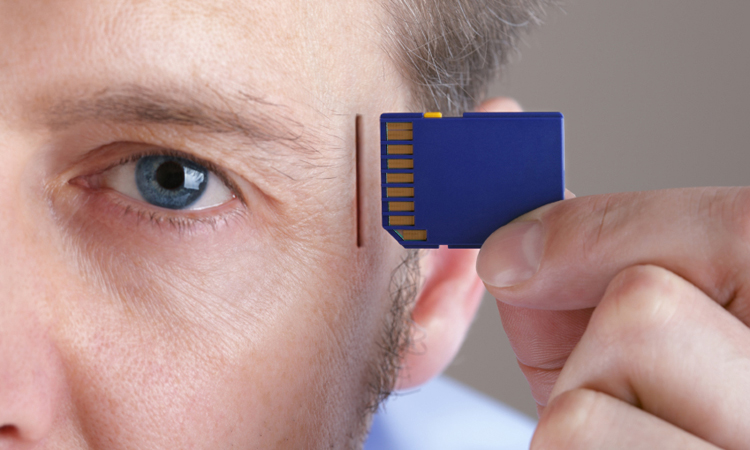
Is death really the final frontier? While no one, so far, has been able to cheat it, the desire to do so has existed throughout the ages. For those who fear the Reaper, recent decades have given rise to hope in the form of cryonics: a process that counts on future scientific advances to restore the frozen dead to new life (alas, no one has come back as yet). But today there’s a whole new immortality game in town: mind transfer, also called mind copying, brain back-up, mind uploading or whole brain emulation. Whatever you call it, what once was considered simply the far-out stuff of Hollywood and science fiction, is now being pursued by some in the scientific community as a potential way for us to live forever.
If you’ve seen the recent sci-fi thriller Self/less, about a wealthy aristocrat dying of cancer who undergoes a medical procedure to have his consciousness transferred into another body, you have some inkling about it. But that’s Hollywood; in real life, is mind uploading possible, probable, preposterous? First up is the little matter of…
Neurons, neurons and more neurons
Just how all the brain’s connections actually work nobody knows. For now, a scientific gold rush is on to decipher and map the brain’s complex activity. With nearly 100 billion neurons and 100 trillion connections, deciphering its activity remains one of medicine’s greatest challenges. The U.S. Brain Research through Advancing Innovative Neurotechnologies (BRAIN) Initiative seeks greater understanding of the brain in order to produce new ways to combat and prevent debilitating neurological and psychiatric disorders such as Alzheimer’s disease. But some in the scientific community have other motives.
The secret to immortality: all in our heads?
Is the essence of who we are, our memories, personalities and, perhaps even our consciousness, found in brain patterns of neural networking—the firing of a neuron and the electrochemical signal that travels from the axon of one neuron to the dendrite of another? And, if we are nothing more than individual neurons and the relationships between them, could those patterns be copied to a code to replicate the essence, or identity, of an individual?
Dutch neuroscientist and neuroengineer Randal A. Koene thinks so. Koene is on a mission to reduce the activity of brain substrates, parts of the brain which underlie specific behaviors or psychological states, to computations and reproduce those computations in code in order to achieve substrate-independent minds, or SIM.
Survival of the species
Koene states, on his website Carboncopies.org, that this “will open up a world of new environments and enable sustainable living with different resource requirements than our current ones. In effect, we can diversify and thereby improve the odds of personal, cultural and species survival.
“By providing brain-machine interfaces and access to brain functions, we can eventually enhance the mind to improve communication, mutual understanding, adaptation to new challenges and further the evolution and development of human society.”
Life on Mars, anyone?
The 2045 Initiative
Dmitry Itskov, a Russian multimillionaire, is another fellow combatant in the fight against mortality. His nonprofit organization, the 2045 Initiative, aims to “create technologies enabling the transfer of an individual’s personality to a more advanced non-biological carrier, and extending life, including to the point of immortality.” His organization’s Avatar Project intends to complete several phases throughout the upcoming decades:
1. Avatar A: The creation of an anthropomorphic robot controlled by a brain-computer interface—to help those who work in dangerous environments, and the disabled
2. Avatar B: An autonomous life-support system for the human brain linked to a robot; patients with an intact brain will be able to return to a fully functioning bodily life
3. Avatar C: The contents of a person’s brain uploaded into a synthetic one, expanding human capabilities
4. Avatar D: A hologram-like avatar to replace bodies completely (by the year 2045)
New robo-you: still you?
The movement is not without its detractors—Duke University neuroscientist Miguel Nicolelis, for one. At a 2013 meeting of the American Association for the Advancement of Science in Boston, Nicolelis said, “The brain is not computable and no engineering can reproduce it.” And then there’s that thorny issue of defining just what is a person’s essence and consciousness, some would even say soul—can that be replicated?
Far out
It may all sound far out, but thousands of people are game. Even the Dalai Lama (yes, really) has given his blessing and support to Itskov’s 2045 Avatar project. If we could, should, would we really want to live forever in artificial bodies? If it’s not really us, should we care?…Only time will tell if death isn’t the final frontier.
To find out about Rose’s thoughts on how to live a happier life, click here


